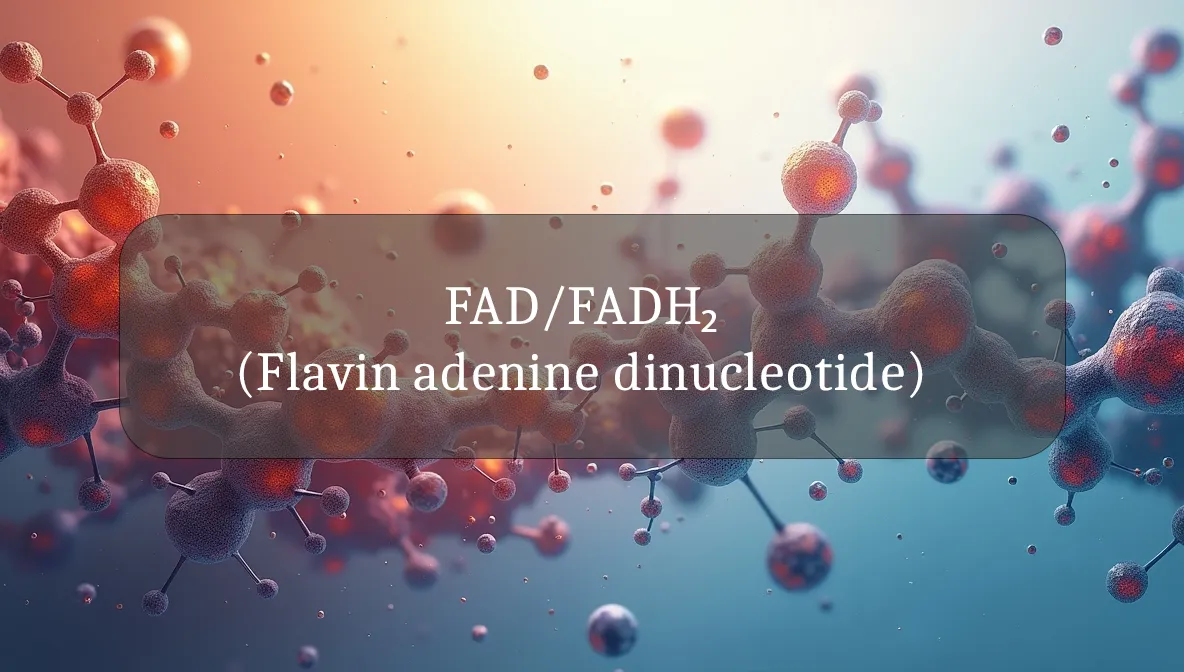Energy-Charging Molecules Powering Your Cells
FAD (Flavin Adenine Dinucleotide) and its reduced form, FADH2, are like your body’s tiny energy couriers, helping turn food into fuel to keep you moving and thriving. These molecules, derived from Vitamin B2 (riboflavin), are critical for energy production and overall wellness. Let’s explore what FAD/FADH2 are, how they support your health, and how to ensure your body has what it needs to keep them working.
Chemical Identity and Type
FAD is a coenzyme, a molecule that partners with enzymes to speed up chemical reactions in your body. It’s made from riboflavin (Vitamin B2) combined with adenine (a DNA building block). FADH2 is the “charged” version of FAD, carrying extra electrons after picking them up during metabolic processes. Both are key players in the mitochondria, your cells’ power plants, where they help produce energy from carbs, fats, and proteins.
Biological Role and Benefits
FAD and FADH2 are essential for keeping your energy levels high and your body functioning smoothly:
- Energy Production: FADH2 delivers electrons to the mitochondria’s electron transport chain, generating ATP (your body’s energy currency) to power muscles, organs, and brain function.
- Fat Metabolism: FAD helps break down fatty acids, providing energy for endurance activities or fasting periods.
- Antioxidant Defense: FAD supports enzymes that neutralize harmful free radicals, protecting cells from damage and supporting long-term health.
- Detoxification: It aids liver enzymes in processing toxins and drugs, keeping your system clean.
- Cell Repair and Growth: FAD/FADH2 contribute to DNA repair and protein synthesis, promoting healthy tissues and recovery.
By fueling energy and protecting cells, FAD/FADH2 keep you energized, focused, and resilient.
Dietary or Natural Sources
Your body makes FAD/FADH2 from riboflavin (Vitamin B2), so dietary sources focus on B2-rich foods:
- Dairy: Milk, yogurt, and cheese (1 cup milk: ~0.4 mg B2).
- Eggs: One large egg provides ~0.2 mg B2.
- Meat and Poultry: Beef, chicken, and liver (3 oz beef liver: ~3 mg B2).
- Fish: Salmon and mackerel (3 oz salmon: ~0.2 mg B2).
- Green Vegetables: Spinach, broccoli, and asparagus (1 cup spinach: ~0.1 mg B2).
- Whole Grains and Fortified Foods: Oats, quinoa, and fortified cereals (1 cup fortified cereal: ~0.4–1.7 mg B2).
- Nuts and Seeds: Almonds (1 oz: ~0.3 mg B2).
- Supplements: B2 supplements (5–100 mg) or B-complex vitamins support FAD production.
A varied diet easily meets B2 needs, ensuring FAD/FADH2 production.
Signs of Imbalance or Dysfunction
FAD/FADH2 imbalances are tied to riboflavin (B2) deficiency, which is rare but possible:
- Low FAD/FADH2 (B2 Deficiency):
- Fatigue, low energy, or weakness due to reduced energy production.
- Cracked lips, sore throat, or mouth sores.
- Dry, scaly skin or rashes, especially around the mouth or nose.
- Red, itchy eyes or sensitivity to light.
- Rarely, anemia or nerve issues (tingling, numbness).
- Excess FAD/B2:
- B2 is water-soluble and safe at high doses (no upper limit set).
- Excess B2 turns urine bright yellow but is harmless.
If you notice persistent fatigue, skin issues, or mouth sores, consult a doctor to check for B2 deficiency or other concerns.
Supporting Optimal Levels or Function
To keep FAD/FADH2 working effectively:
- Eat B2-Rich Foods: Include 1–2 servings of B2 sources daily (e.g., eggs, spinach, or dairy). Adults need 1.1–1.3 mg of riboflavin daily (men: 1.3 mg; women: 1.1 mg; pregnant: 1.4 mg).
- Pair with Other Nutrients: Combine B2 foods with other B vitamins (e.g., B12 in fish, B6 in poultry) for better energy metabolism.
- Support Mitochondrial Health: Eat antioxidant-rich foods (berries, nuts) and exercise regularly to boost mitochondrial function, where FAD/FADH2 shine.
- Stay Hydrated: Water supports metabolic processes, including FAD/FADH2 activity.
- Supplements (If Needed): B2 or B-complex supplements (10–50 mg B2) are rarely needed but can help for high-energy lifestyles or deficiency risks.
Consult a doctor if you’re considering supplements or have absorption issues.
Safety, Interactions, and Precautions
FAD/FADH2 and riboflavin are safe, with minimal risks:
- Medical Conditions: Malabsorption disorders (e.g., celiac, Crohn’s) or thyroid issues may reduce B2 absorption, impacting FAD production.
- Medication Interactions: Some drugs (e.g., certain antidepressants or antipsychotics) may lower B2 levels. Discuss with your doctor if on long-term medications.
- Allergies: Rare allergic reactions (rash, swelling) can occur with B2 supplements. Use high-quality, tested products.
- Moderation: High B2 doses (above 100 mg) are safe but unnecessary, as excess is excreted.
Fun Fact
Did you know FAD gives some foods their glow? The bright yellow color of riboflavin (B2) in FAD is why your urine turns neon yellow after taking a B-complex vitamin—it’s your body flushing out the excess in style!
Citations
- National Institutes of Health (NIH): Riboflavin Fact Sheet for Health Professionals.
- Mayo Clinic: B Vitamins and Energy Metabolism.
- Cleveland Clinic: Vitamins for Mitochondrial Health.
- Journal of Nutritional Biochemistry: Flavin Adenine Dinucleotide in Metabolism (2019).
- Harvard T.H. Chan School of Public Health: The Nutrition Source – Riboflavin.

